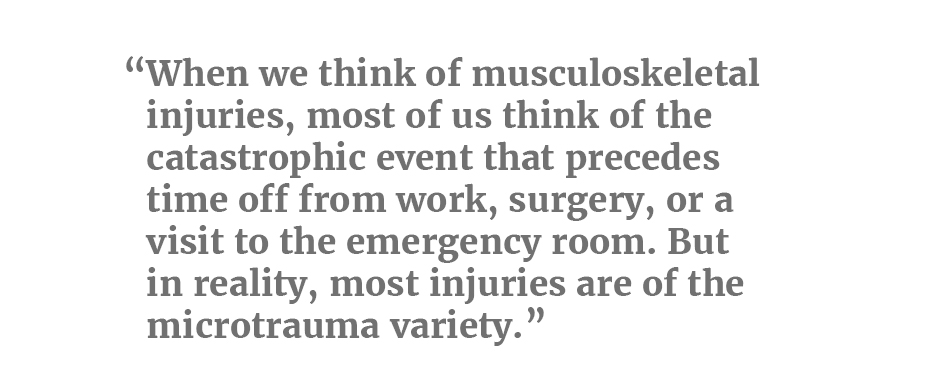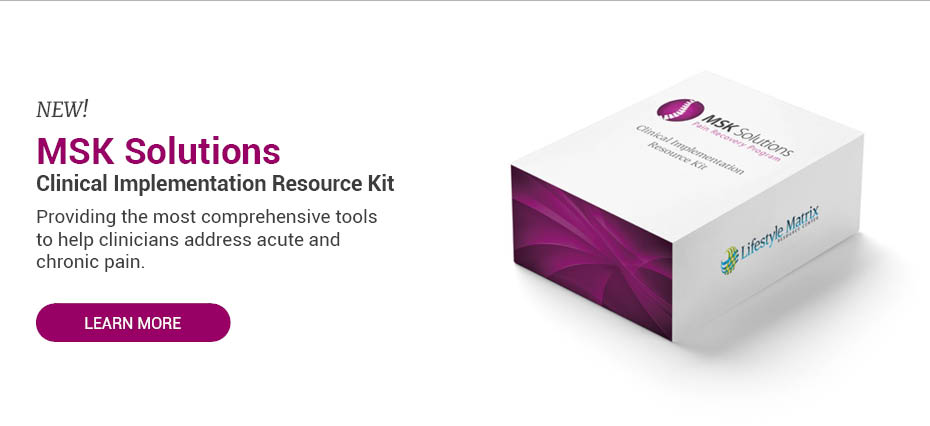It was a typical Monday morning. I walked into one of our treatment rooms and encountered a fit, 53-year-old female patient in severe pain. She had severe right cervical pain that radiated into her right arm and hand. Her debilitating pain drastically limited her ability to move her neck in all directions and perform simple daily activities. A subsequent orthopedic and neurological exam revealed obvious signs of both sensory and motor pathway involvement and warranted further investigation. X-rays and MRI confirmed a suspected disc protrusion into the C5-C6 intervertebral foramen, as well as a past C5-C6 compression fracture and severe disc height loss at the levels of C4-C7.
Without knowing this patient’s history, most clinicians would assume a traumatic event occurred, such as a motor vehicle accident or violent fall. Surprisingly, it was a not a dramatic injury that caused this excruciating pain—all she did was a two-minute plank during a CrossFit class. Why did this seemingly innocuous exercise result in such major consequences?
What is Microtrauma?
When we think of musculoskeletal injuries, most of us think of the catastrophic event that precedes time off from work, surgery, or a visit to the emergency room. But in reality, most injuries are of the microtrauma variety. It’s easy to overlook posture, lifting mechanics, and hundreds of seemingly harmless activities we perform every day. Just as a rubber band loses its elasticity with constant tension and stretching, our joints, tendons, ligaments and connective tissue can only endure so much accumulated mechanical stress. In fact, these strains may be an underlying cause of a catastrophic injury just waiting to finally “snap.”

Microtrauma injuries are overuse injuries from chronic repetitive motions that cause microscopic damage, muscle and connective tissue imbalances and, over long periods of time, alter and limit activities. The area of injury undergoes a mechanical stress reaction that may include microtears, inflammation, swelling and tenderness, usually in a pointed area. Early microtrauma may not be detectable, obvious, painful, or have any swelling or tenderness. As overuse continues, the microscopic imbalance becomes more extreme, and further tearing, weakness and tissue degeneration increases until symptoms or physical limitations manifest.
Even after microscopic injury occurs, our bodies go through a similar healing process, but on a much smaller scale, by recruiting white blood cells and fibroblasts to clean up and lay down new collagen fibers. The problem with chronic micro trauma is that we may be completely unaware, or completely ignore, the little ache or limitation in range-of-motion and push through the annoyance while prolonging the entire healing process. Unfortunately, connective tissue healing requires the most valuable resource: time. Most connective tissue is comprised of type I and II collagen fibers, along with glycosaminoglycans (GAGs) that surround and align collagen fibers. Injury may cause excess deposition of type III collagen, which is weaker, disorganized, and difficult to remodel and repair even over long periods of time.
In this patient‘s case, mechanical stress from exercise was the last straw, but an old whiplash injury from her late teens, inflammation from stress associated with her career and raising a large family, sleep deprivation, and hormonal change due to perimenopause all contributed to the final insult that gave such dramatic presentation. Understanding all circumstances around the patient injury is vital for complete healing.
Lifestyle Factors and Microtrauma
One important factor to consider is that, on average, Americans devote about 10 hours per day to screen time.1 Inactivity activity is a major issue, but the forward head posture is what strains the tendons, ligaments and muscles, and puts uneven stress on the joints in the spine. This leads to deformation and weakness in the supportive tissue around the neck joint. The straw that will break the camel’s back, so to speak, is a minor stretch of the neck to check behind the vehicle as you back out, or some other innocent movement.
Diet and nutrition, along with lifestyle changes appropriate for the patient, can help to offset this microscopic cascade and ensure complete healing is not limited or unresolved. Most diets are high in pro-inflammatory trans fats, lack anti-inflammatory phytonutrients, are deficient in high-quality protein, and lack essential amino acids. All these nutrients are required for our bodies to build muscle, collagen, cartilage, tendons, ligaments, skin, and even bone. It is for this reason that even with proper physical rehabilitation, the patient may not heal completely.
Stress and sleep are also key factors when considering the healing process. It is well-documented in the medical literature that stress limits wound healing time, and overall healing in the body.2 Sleep is the best time for our bodies to repair and regenerate an injury, and limited sleep can delay healing.3
Back to our patient: Along with chiropractic care, a specific rehabilitation program, a focus on reducing stress and improving sleep, my treatment protocol also included high-quality supplements that provided essential amino acids, collagen peptides, hyaluronic acid, glucosamine and chondroitin to enhance and compliment the healing process. Although surgery was contemplated, the patient‘s pain was greatly reduced in three weeks, function was fully restored in three months, and all residual symptoms resolved in six months. Cases like this one, that took decades to develop, need time and patience to fully resolve.
The Bottom Line
Nutrition, physical and psychological balance are the core elements that make up a concept called The Healing Matrix. Elements of nutrition, physical and psychological balance are essential to reducing pain and promoting healing in the body. If you’re interested in a comprehensive approach to treating pain that goes beyond managing symptoms and risking pill dependency, check out the MSK Solutions Pain Recovery Program.
ADRIAN DEN BOER DC, ND

Educated in both the Netherlands and the United States, Dr. Adrian den Boer is a board-certified and licensed Naturopathic and Chiropractic physician. In addition, Dr. den Boer is fully certified as a functional medicine doctor. Dr. den Boer has treated over 10,000 patients successfully by utilizing multiple resources to manage patient care. Most recently, he joined the Lifestyle Matrix Resource Center as the Clinical Expert serving the MSK Solutions Pain Recovery Program.
References
1Jacqueline H. Americans devote more than 10 hours a day to screen time, and growing. https://www.cnn.com/2016/06/30/health/americans-screen-time-nielsen/index.html.
Accessed September 11, 2018.
2Jean-Philippe Gouin and Janice K. Kiecolt-Glaser. The impact of psychological stress on wound healing: methods and mechanisms. Immunol Allergy Clin North Am. 2011 Feb; 31(1): 81–93. doi:10.1016/j.iac.2010.09.010
33. S. Guo and L.A. DiPietro. Factors Affecting Wound Healing. J Dent Res. 2010 Mar; 89(3): 219–229. doi:10.1177/0022034509359125






